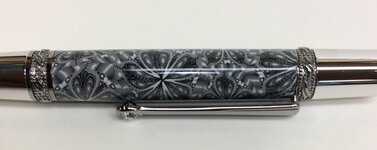What you really have to understand about polyclay is that it is an ultra-light material that is BARELY bonded to the brass barrel. It has a light flex built into it, so it can take a certain amount of stress, but one single mistake with a TOOL and you've destroyed it. It's always best to just sand them down using LIGHT pressure.
Lateral sanding is meant to reduce the ridges or ripples you get from radial sanding (sanding with the lathe turned on leaves tiny rings around the barrel). By sanding directly across them, you break the radial rings, allowing the next progressively finer grit to remove them by making the blank more even, with no raised rings left behind of the previous grit. The result is a much smoother surface, and the smoother the surface before application of CA topcoat, the better.
I would sand starting from 220 grit, stopping the lathe to sand laterally at least every other grit (most recommend every single grit), till I reached at least 600 grit (I usually go to 1000 grit on my wood pens). Once I reached the last grit, I do my cleanup ... wipe the blank down with the lathe turned on, using rubbing alcohol. The alcohol dries very fast, and picks up fine particles quickly. I always use a paper towel applicator at my lathe.
After cleanup, one coat with Minwax Stain'n'Seal (this contains Boiled Linseed Oil for the CA to react to) and then the first coat of CA while it's still wet. This helps the CA to go on much smoother. I follow up with 5 - 8 more coats of just CA, sometimes sitting down at my computer for 20 - 60 minutes, watching anime, letting the CA set.
Once my CA coats are done, if the surface even LOOKS a little wavy, I start my wet sanding at 1000 grit, sanding laterally with the lathe off, and then every other grit on the way up through micromesh to 12,000 grit. This is followed by Meguair's Plast-X and Turtle Wax Hard Coat.
The Plast-X gives it a glass-like smooth surface shine, the Turtle Wax helps repel dust, dirt, moisture, and fingerprints. (You can feel free to use your own preferred products at the end in place of these, but you'll want SOMETHING rather than nothing!)
The CA protects the blank from dings and dents that it normally wouldn't survive, and gives it that beautiful crystal clear coating that sets it apart from plain sanding up to 1000 grit ... all the details are magnified for the world to see (this includes mistakes!!), so always examine your blank BEFORE finishing as well as after. (The brand you use generally doesn't matter, so long as your resulting clear coat is strong and not stress cracking due to misuse of accelerator or shifting moisture content.)
I hope this explanation was easier for you to understand than Edstreet's and Toni's articles. They are both awesome in their fields... While Edstreet makes the pens, for the most part, and Toni makes the polyclay art, she does occasionally take the time to turn a pen herself, and the results are always stunning!
Edstreet does take a condescending tone, at times, but he's a very intelligent and helpful person. He's been here a while, so he keeps seeing the exact same questions over and over and over, month after month, from new people who don't know how to use the resources at their fingertips. Please don't blame him for being cryptic and hard to understand, at times. He's really good at what he's done, and has made great contributions for us all in his articles.

